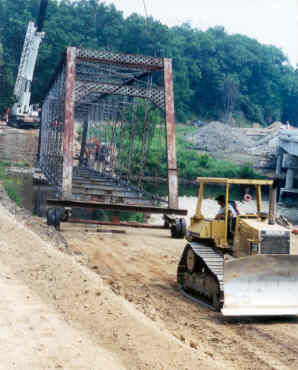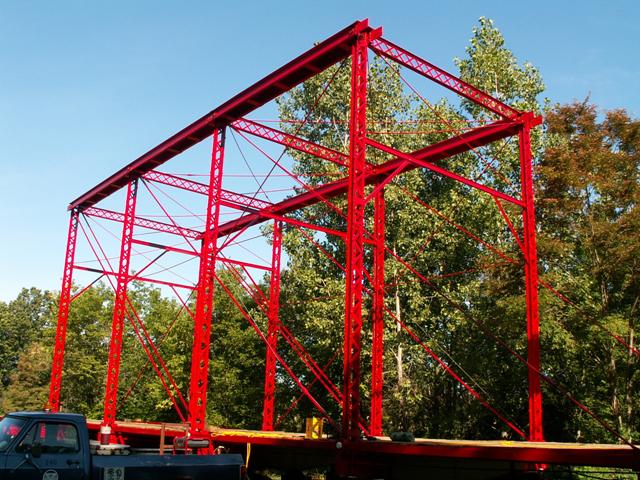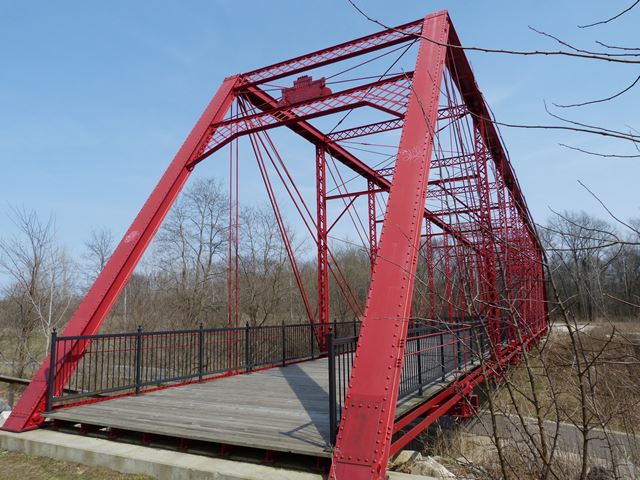We Recommend:
Bach Steel - Experts at historic truss bridge restoration.
BridgeHunter.com Phase 1 is released to the public! - Visit Now
Charlotte Highway Bridge
Centerline Bridge

Primary Photographer(s): Nathan Holth
Bridge Documented: 2006 - April 16, 2014
Rural: Calhoun County, Michigan: United States
Metal 11 Panel Pin-Connected Whipple (Double-Intersection Pratt) Through Truss, Fixed
1886 By Builder/Contractor: Buckeye Bridge Works of Cleveland, Ohio
2007
173.0 Feet (52.7 Meters)
176.8 Feet (53.9 Meters)
14.4 Feet (4.39 Meters)
1 Main Span(s)
34200072000B010

View Information About HSR Ratings
Bridge Documentation
Additional Information: View an episode of PBS show Destination Michigan which features Historic Bridge Park
View Archived National Bridge Inventory Report - Has Additional Details and Evaluation
This bridge has been moved and restored, and now resides in Historic Bridge Park.

Formerly located in Ionia County, the Charlotte Highway Bridge is one of only three Whipple (double-intersection Pratt) highway bridges left in Michigan, and is a relatively large span example. It is also the only remaining bridge in Michigan built by the Buckeye Bridge and Iron Works of Cleveland Ohio. Very few bridges by this company remain nationwide. The company was later bought out by the Variety Iron Works of Cleveland, Ohio. The Charlotte Highway Bridge is the fifth truss bridge to be erected in Historic Bridge Park. It forms an impressive entrance into the park as it passes over the park entry road with its complex truss configuration and bright red paint.
Historical Text Describing Buckeye Bridge Works
Source: Leading Manufacturers and Merchants of the City of Cleveland and Envrions, 1886
M. & J. Miller, Buckeye Bridge and Boiler Works, near
corner of Case Avenue and Hamilton Street. -A prominent house in Cleveland
engaged in contracting for the erection of bridges, etc, is the Buckeye Bridge
and Boiler Works, located at Case Avenue and Hamilton street, of which Messrs.
M. & J. Miller are the enterprising proprietors. This business was established
in 1872 by Messrs. Miller & Jameson, who were succeeded in 1878 by Mr. J.
Miller. Eventually in 1886 the present firm was organized, the copartners being
Messrs. M. and J. Miller, both of whom are thoroughly practical men, and possess
an intimate knowledge of all kinds of bridge construction and boiler-plate work.
The new works and office are located near the corner of Case avenue and Hamilton
street and are very extensive, having a frontage of 300 feet by a depth of 312
feet. The buildings are thoroughly equipped with the latest improved machinery
and appliances, including machines for dishing heads, plate planers,
steam-riveting machinery, etc. One hundred and twenty mechanics and operatives
are employed in the various departments of the Buckeye Bridge and Boiler Works,
while the machinery is operated by a seventy-horse power steam engine. Messrs.
M. & J. Miller manufacture to order all kinds of iron, truss, and beam bridges,
also boilers, tanks, stills, blast furnaces, and all kinds of plate work, jail
cells, and bank vaults. The various productions of this responsible house have
no superiors for quality of materials, workmanship, and general excellence. The
firm built the Willoughby bridge at Willoughby, Ohio, also bridges at Ogden and
Golden City, Utah, and numerous others in all parts of the country. Messrs. M. &
J. Miller give their close personal supervision to the operations of their
works, thus insuring only such iron work as will withstand the most critical
tests. Both partners were born in Reading, Pa., but have resided in Cleveland
for the last quarter of a century. They undertake the construction of all kinds
of iron bridges, and no more honorable, reliable, and efficient bridge builders
can be found.
Journal of Visits To This Bridge During Restoration:
During fall of 2005, I visited and found that the only activity that had gone on at the park is the creation of reproduction floor beams for the bridge. The original floor beams were apparently in too bad of a shape to be restored. The reproduction beams are true to the original, and they are riveted together the way the originals were.
A visit in February of 2006 revealed that the flooring system of the bridge was assembled. Also, the rest of the bridge pieces had been brought on site. I found this fascinating, as I always like to see what the parts look like when separate and on their own. It is often easier to visualize how everything fits together on a truss bridge when you see it in pieces like this. As a result, I have added a bunch of photos to the gallery.
An August 2006 visit revealed that the actual truss assembly is in progress, and a portion of the bridge's trusses were put together. Some of the crew was there, and I talked with them a bit and learned that they were hoping to get it put together by this winter. I have added photos to the gallery from this visit.
Information and Findings From Michigan Historic Bridge InventoryNarrative Description
The Charlotte Highway Bridge is one of only three double-intersection Pratt (Whipple) trusses extant in Michigan. The Builder, the Buckeye Bridge Works of Cleveland, Ohio, was a significant metal truss bridge builder in the midwest in the nineteenth century, and this is the only known surviving example of their work in Michigan. |
This bridge is tagged with the following special condition(s): Reused
![]()
Photo Galleries and Videos: Charlotte Highway Bridge
Reassembly and Pre-2014 Photo
A collection of overview and detail photos including photos showing the bridge being reassembled at the park. This photo gallery contains a combination of Original Size photos and Mobile Optimized photos in a touch-friendly popup viewer.Alternatively, Browse Without Using Viewer
![]()
2014 Bridge Photo-Documentation
Original / Full Size PhotosA collection of overview and detail photos. This gallery offers photos in the highest available resolution and file size in a touch-friendly popup viewer.
Alternatively, Browse Without Using Viewer
![]()
2014 Bridge Photo-Documentation
Mobile Optimized PhotosA collection of overview and detail photos. This gallery features data-friendly, fast-loading photos in a touch-friendly popup viewer.
Alternatively, Browse Without Using Viewer
![]()
Maps and Links: Charlotte Highway Bridge
The above map shows the current location of the bridge. The bridge originally crossed the Grand River on Charlotte Highway, Ionia County, Michigan,
Coordinates (Latitude, Longitude):
Search For Additional Bridge Listings:
Bridgehunter.com: View listed bridges within 0.5 miles (0.8 kilometers) of this bridge.
Bridgehunter.com: View listed bridges within 10 miles (16 kilometers) of this bridge.
Additional Maps:
Google Streetview (If Available)
GeoHack (Additional Links and Coordinates)
Apple Maps (Via DuckDuckGo Search)
Apple Maps (Apple devices only)
Android: Open Location In Your Map or GPS App
Flickr Gallery (Find Nearby Photos)
Wikimedia Commons (Find Nearby Photos)
Directions Via Sygic For Android
Directions Via Sygic For iOS and Android Dolphin Browser
USGS National Map (United States Only)
Historical USGS Topo Maps (United States Only)
Historic Aerials (United States Only)
CalTopo Maps (United States Only)




